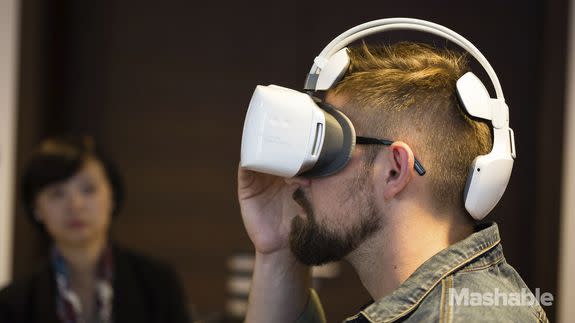Alcatel's Vision VR headset doesn't need a phone

BERLIN — Virtual reality headsets these days fall in roughly two categories. There are those tethered to a computer, aimed mostly at gamers, like the Oculus Rift or the HTC Vive, and mobile ones that combine with a smartphone, like Samsung's Gear VR or Google's Cardboard.
China's Alcatel did something different last year when it launched the Alcatel Idol 4S phone, whose packaging doubled as a simple VR headset. Now, the company has taken it a step further by announcing a standalone VR headset — one that does not need a phone or a computer to work.
SEE ALSO: Alcatel Idol 4S:come for the hot affordable phone, stay for VR
The advantage of this approach is obvious: You can enjoy VR anywhere, and move freely without wires getting in the way — although that comes with the caveat that you won't want to move much without being able to see what's around you in the real world.
To achieve this, Alcatel basically put a smartphone of its own into the headset, called the Vision. It's an Android Marshmallow-powered device with an octa-core CPU, 3GB of RAM, 32GB of storagae Bluetooth, LTE, Wi-Fi, accelerometer, gyroscope and proximity sensor. It's basically everything you expect from a modern smartphone, only hidden inside the headset. It has two 3.8-inch AMOLED screens, each with a 1,080 x 1,020 pixel resolution.
To keep the weight down, Alcatel did something smart with the design: The front part of the headset is fairly straightforward and similar to, say, Samsung Gear VR. But keeping it fastened on your head is a sort of a head brace, with the 3,000mAh battery hidden in the part of the headset that leans on the back of your head. The design is not perfect yet — Alcatel tells me the part around the nose needs more work, and it does in my case — but overall it kept the headset quite light on my head, which is arguably more important than looks.

Image: Michael Rathmayr/Mashable
I've spent a short time with the headset, which Alcatel tells me is pretty close to the one we'll see in stores, and the experience was somewhere between the one you get with Google Cardboard and Oculus Rift.
An Alcatel rep told me the idea is to sell the headset as a standalone, and not bundled with a phone. It is, he pointed out, an entirely new business unit for the company — one they're taking seriously. Alcatel is working with partners on a payment system that will enable users to purchase apps, and a Unity-based SDK will be released at some point as well.
The price and exact date of availability haven't been finalized yet, but we can expect it to cost between $500 and $600. It will be shipping in China in the last quarter of 2016; in the U.S., it should become available from the first quarter of next year.
